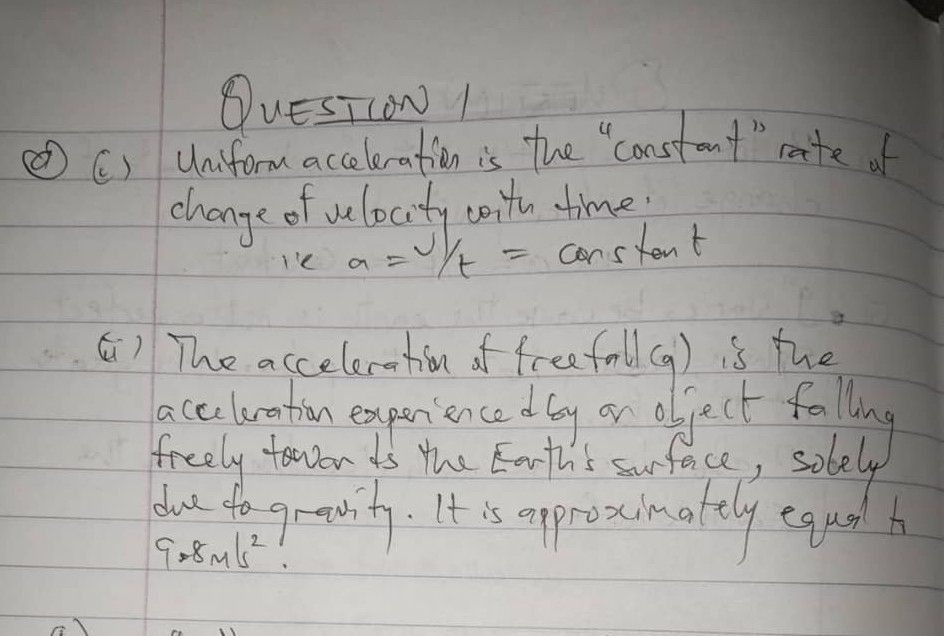PHYSICS OBJ
01-10: BBCCAABBCB
11-20: DABCCADDCA
21-30: CDDBABAAAC
31-40: CBBABDBBCA
41-50: BBCCBCDCCD
COMPLETED
NABTEB 2025 PHYSICS ANSWERS
INSTRUCTION: ANSWER FOUR(4) QUESTIONS ONLY
(1ai)
Uniform Acceleration:
Uniform acceleration refers to a condition in which the velocity of an object changes at a constant rate over time. This means the object gains or loses equal amounts of velocity in equal intervals of time.
(1aii)
Acceleration of Free Fall due to Gravity:
This is the acceleration experienced by an object when it falls freely under the influence of the Earth’s gravitational pull alone, without air resistance. It is represented by ‘g’ and has an average value of 9.8 m/s² near the Earth’s surface.
(1b)
(i) Latitude: The Earth is an oblate spheroid flattened at the poles and bulging at the equator. Since the radius is greater at the equator, objects are farther from Earth’s center, causing weaker gravitational pull at the equator compared to the poles.
(ii) Altitude: As altitude increases, the distance from the Earth’s center increases. Since gravitational force is inversely proportional to the square of the distance, the value of ‘g’ decreases with altitude.
(1c)
Given:
Initial velocity (u) = 100m/s
Projection angle (θ) = 30°
Tower height = 100m
g=10m/s²
(i) Maximum Height Above Ground:
Hmax = (tower height + (usinθ)²)/2g
= (100 + (100 × sin30)²)/(2 × 10)
= (100 + (2500)/20
= 100 + 125
= 225m
(ii) Time to Reach Maximum Height:
t = (usinθ)/g
t = (100 × sin30)/10
t = 5s
(iii) Horizontal Distance to Point Z:
Time to fall(tfall): (√2Hmax/g) = (√2×225/10) =
= (√45) = 6.71s
Total time of flight(T)
= t + tfall = 5 + 6.71 = 11.71s
Horizontal distance(R)
= (ucosθ) ×T
= (100×cos30)× 11.71
= (100×0.866) × 11.71
1014.09m
===========================
(2ai)
A machine is a device used to overcome a load at one end by the application of an effort at another end. It helps to make work easier by either multiplying the force or changing its direction. Examples of simple machines include the screw jack, can opener, and pulley system.
(2aii)
Mechanical Advantage (M.A.):
Mechanical Advantage is the ratio of the load lifted by a machine to the effort applied to it.
M.A = Load/Effort
Velocity Ratio (V.R.):
Velocity Ratio is the ratio of the distance moved by the effort to the distance moved by the load. It is a measure of the geometry of the machine.
V.R = Distance moved by effort/Distance moved by load
Efficiency (η):
Efficiency of a machine is the ratio of the useful work output to the total work input, often expressed as a percentage.
η = (M.A/V.R) ×100%
(2b)
The efficiency of a machine is usually less than 100% because some energy is always lost due to factors such as friction between moving parts, deformation, and other inefficiencies. These losses convert some of the input energy into heat or other non-useful forms, so not all the input work is converted into useful output work. Therefore, the useful work output is always less than the work input, making efficiency less than 100%.
(2c)
Given:
-Pitch of the screw(p) = 44mm = 0.044m
-Length of the tommy bar(r) = 70cm = 0.7m
-Mass of the body(m) = 8000 kg
-Height raised (h) = 20 cm = 0.2 m
-Efficiency(η) = 80% = 0.8
-Gravitational acceleration(g) = 10m/s²
-π = 22/7
(i) Velocity Ratio(VR):
VR = Distance moved by effort/Distance moved by load
VR = (2πr)/p
VR = (2 × (22/7) × 0.7)/0.044
VR = (2 × 22 × 0.1)/0.044
VR = 4.4/0.044
VR = 100
(ii) Mechanical Advantage(MA):
MA = Efficiency × VR
MA = 0.8 × 100
MA = 80
(iii) Effort required to raise the body:
Load = m × g = 8000 × 10 = 80000N
Effort = Load/MA
Effort = 80000/80
Effort = 1000N
(iv) Work done by the effort in raising the body:
Distance moved by effort = VR × height raised = 100 × 0.2 = 20m
Work done by effort = Effort × distance moved by effort
Work done by effort = 1000 × 20
Work done by effort = 20000J
===========================
(3a)
(i) Amplitude: The maximum displacement of a particle in the medium from its rest position as the wave passes.
(ii) Wavelength (λ): The distance between two successive points on the wave that are in phase, such as from crest to crest or trough to trough.
(iii) Frequency (f): The number of complete waves passing a given point per second, measured in hertz(Hz).
(3bi)
DRAW THE IMAGE
[img]https://i.ibb.co/qY9HMBfg/Pulley.jpg[/img]
The diagram of the sonometer shows a one-meter wooden box with a metallic string stretched over it. One end of the string is fixed to a hook on the box, while the other end passes over a pulley attached to a weight hanger that holds slotted weights to vary the tension. Two movable bridges rest on the string to adjust its vibrating length. This setup allows the study of how frequency depends on tension, length, and mass per unit length of the string by producing transverse standing waves.
(3bii)
(i) Ensure the string is tightly fixed at both ends.
(ii) Avoid parallax error when taking measurements.
(3ci)
(i) The angle of incidence is equal to the angle of reflection.
(ii) The incident ray, the reflected ray, and the normal to the surface at the point of incidence all lie in the same plane.
(3cii)
Given:
-Focal length (f) = 5 cm
-Near point (D) = 35 cm
Magnification (M) = (D/f)+ 1
M = (35 / 5) + 1
M = 7 + 1
M = 8
(3ciii)
DRAW THE DIAGRAM
[img]https://i.ibb.co/Jw8pdBQJ/image.jpg[/img]
RELATED POST:
NABTEB Economics 2025 Questions And Answers
NABTEB Government 2025 Questions And Answers
NABTEB Chemistry 2025 Questions And Answers
===========================
(4ai)
Electrolysis is the process by which an electric current is passed through a substance (usually an ionic compound in molten or dissolved form) to cause a chemical change. This change involves the decomposition of the substance into its component parts, where ions gain or lose electrons (reduction or oxidation) at the electrodes.
(4aii)
Given:
-Current (I) = 2 A
-Time (t) = 5 minutes = 300 seconds
-Electrochemical equivalent (Z) = 3.27 × 10⁻⁷ kg/
Mass (m) = Z × I × t
m = 3.27 × 10⁻⁷ × 2 × 300
m = 1.962 × 10⁻⁴
(4bi)
Reactance is the opposition offered by a capacitor or inductor to the flow of alternating current (AC) due to the phase difference between voltage and current. It is frequency-dependent and measured in ohms.
Impedance is the total opposition that a circuit presents to the flow of AC, combining both resistance and reactance. It is a complex quantity measured in ohms and affects both the magnitude and phase of the current.
(4bii)
The resonant frequency is the frequency at which the inductive reactance and capacitive reactance in a series RLC circuit are equal in magnitude but opposite in phase, causing them to cancel each other out. At this frequency, the circuit’s impedance is minimum and purely resistive, and the current is at its maximum.
(4biii)
The power supply voltage of a source is 230 V” means the source provides an AC voltage with an effective (RMS) value of 230 volts. This RMS voltage delivers the same power to a resistor as a 230 V DC supply. The actual voltage varies sinusoidally, with a peak about 1.414 times higher than 230 V.
(4ci)
Potential difference across the capacitor (Vc):
In a series RLC circuit, the total voltage (emf) is given by the phasor sum of the individual voltages across the resistor, inductor, and capacitor:
Vtotal² = VR² + (VL – VC)²
Given:
Vtotal = 240 V
VR = 140 V
VL = 50
Substitute the values into the equation:
240² = 140² + (50 – VC)²
57600 = 19600 + (50 – VC)²
38000 = (50 – VC)²
√38000 = |50 – VC|
194.94 ≈ |50 – VC|
Since the circuit has a current of 10 A, and VL = 50 V, it implies that VC must be larger than VL for a net capacitive effect, so we take the negative sign for (50 – VC):
194.94 = -(50 – VC)
194.94 = VC – 50
VC = 194.94 + 50
VC ≈ 244.94
(4cii)
Given:
I = 10 A
f = 50 Hz
VC ≈ 244.94
First, calculate XC:
XC = VC / I = 244.94 / 10 = 24.494
Now, calculate C:
C = 1 / (2 × π × f × XC)
C = 1 / (2 × π × 50 × 24.494)
C ≈ 1.3 × 10⁻⁴ F = 130
(4ciii)
Inductance of the inductor (L):
The potential difference across the inductor is given by VL = I × XL, where XL is the inductive reactance.
XL = 2πfL
Given:
I = 10 A
f = 50 Hz
VL = 50 V
XL = VL / I
XL = 50 / 10
XL = 5 Ω
L = XL / (2πf)
L = 5 / (2π × 50)
L ≈ 0.0159 H
L = 15.9 mH
(5ai)
Fusion is the process where two light atomic nuclei combine to form a heavier nucleus, releasing a large amount of energy. This reaction powers the sun and stars and occurs at extremely high temperatures and pressures.
Fission is the splitting of a heavy atomic nucleus into two smaller nuclei, along with neutrons and energy. It is the principle behind nuclear reactors and atomic bombs.
(5aii)
(i) Fusion by-products are non-radioactive, unlike fission which produces radioactive waste.
(ii) Fusion involves light elements, making it easier to overcome nuclear repulsion forces compared to splitting heavy nuclei in fission.
(iii) Fusion raw materials like hydrogen isotopes are abundantly and cheaply available
(5aiii)
(i) Field emission
(ii) Thermionic emission
(5bi)
(i) Medical Imaging: X-rays are widely used in radiography to view bones and internal organs.
(ii) Industrial Inspection: Used to inspect the integrity of materials and welds in engineering.
(iii) Security Scanning: Employed in airport scanners and baggage checks.
(5bii)
(i) Hard X-rays have high penetrating power, whereas soft X-rays have low penetrating power.
(ii) Hard X-rays have shorter wavelengths, while soft X-rays have relatively longer wavelengths.
(iii) Hard X-rays are used for imaging dense structures like bones, whereas soft X-rays are used for imaging soft tissues or surface layers.
(5ci)
Half-life is the time taken for half of the radioactive nuclei in a sample to decay or transform into another element or isotope. It is a constant characteristic of each radioactive substance.
(5cii)
Given:
Half-life = 25 hours
Total time = 75 hours
Number of half-lives = 75/25 = 3
Fraction remaining = (1/2)³ = 1/8
After 75 hours, 1/8 of the original radioactive nuclei will remain
(5ciii)
(i) Alpha Emission:
²²⁶₈₈X —-> ²²²₈₆Y + ⁴₂H
(ii) Beta Emission:
²²²₈₆Y —-> ²²²₈₇Z + ⁰₋₁e
(iii) Gamma Emission:
²²²₈₇Z* —-> ²²²₈₇Z+γ
COMPLETED

Mr. Femi is an education blogger who simplifies exam updates and study tips for Nigerian students. His goal is to make learning smart, easy, and rewarding.


1 thought on “NABTEB Physics 2025 Questions And Answers”